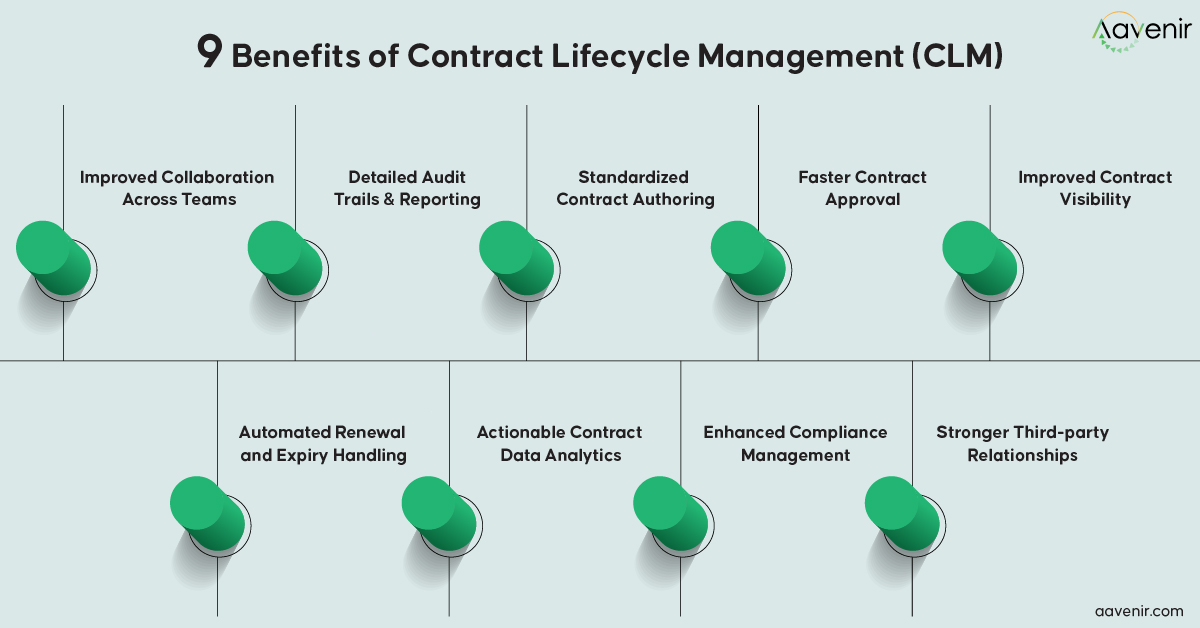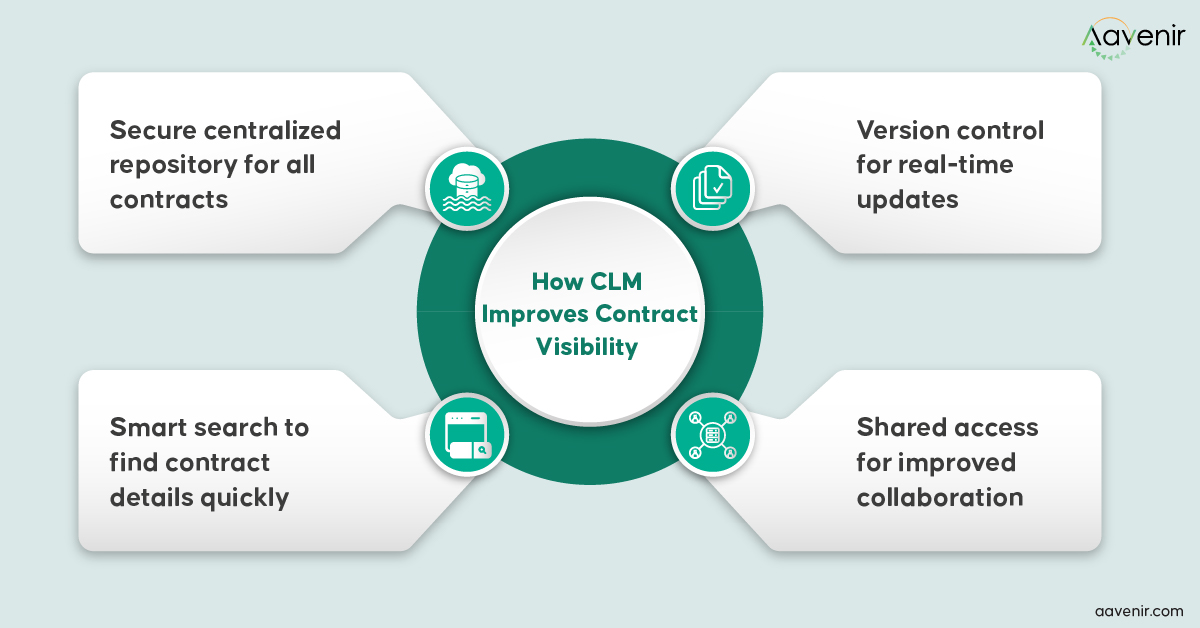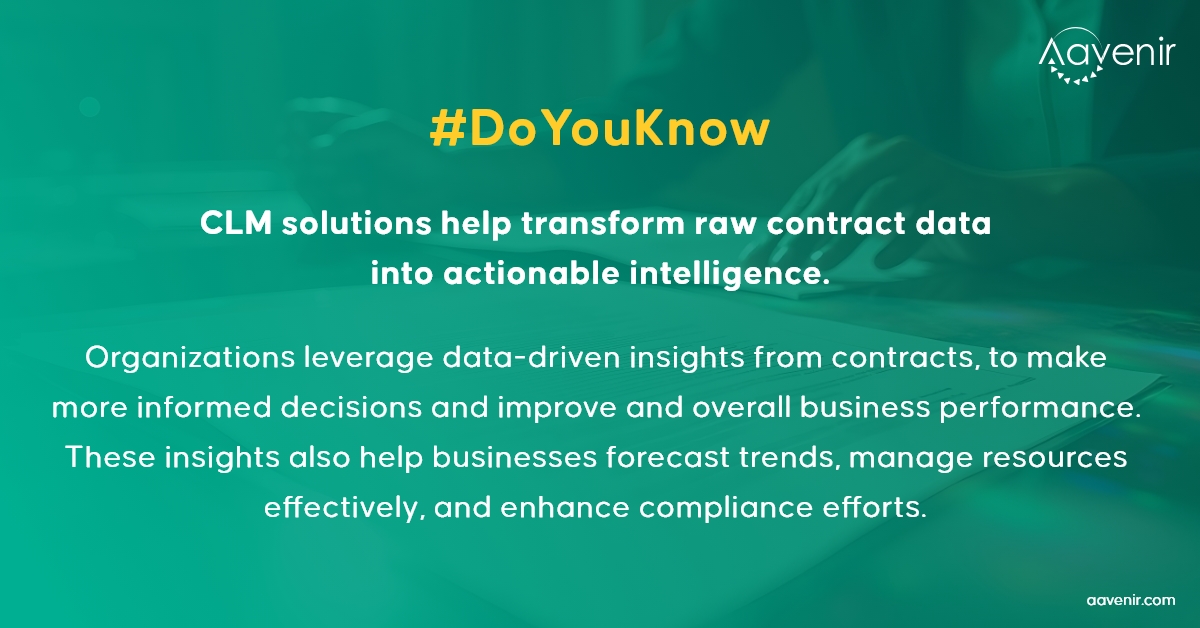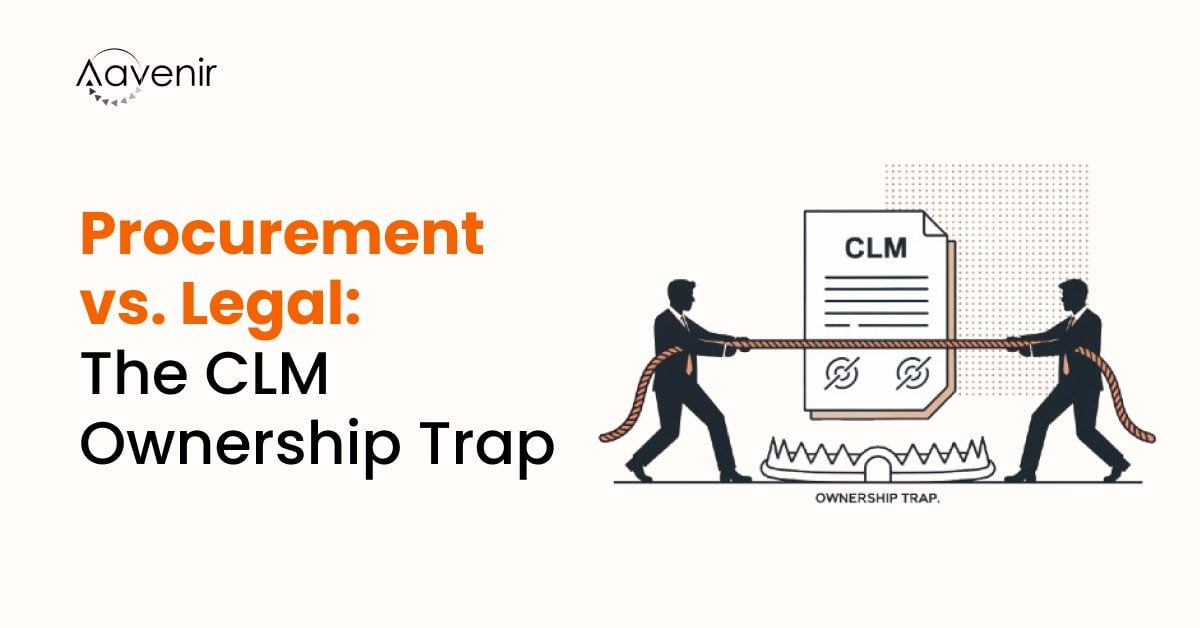Contracts are the lifeblood of business relationships, defining obligations, expectations, and the terms of engagement between parties.
Yet, managing these contracts throughout their lifecycle—from creation and negotiation to execution and renewal—can be complex and time-consuming. Inefficient contract management can lead to missed opportunities, increased business risks, and unnecessary additional costs.
An effective contract lifecycle management (CLM) system helps teams complete all contract-related tasks quickly and efficiently throughout a contract’s lifecycle.
This article lists numerous advantages of contract management and explores how CLM makes it easier for businesses to manage deals and agreements among stakeholders.
9 Benefits of Contract Lifecycle Management
Recognizing the CLM benefits and importance of contract lifecycle management will help teams evaluate their current systems and make better decisions to improve the relevant processes.

1. Improved Collaboration Across Departments
Legal, sales, procurement and IT are a few of the many departments that work together throughout the contract lifecycle. Data remains fragmented as these teams use different tools for their day-to-day operations, leading to a disjointed process.
CLM systems create a single source of truth and provide a common platform for teams to work together. Every team member, whether from sales or legal, can contribute to the contract in real time while having complete visibility across the process. Centralized access is valuable not only for drafting but also for ongoing contract monitoring and compliance checks.
Role-based access to contract data at various levels can further secure and streamline the process by ensuring that only authorized personnel can view or edit specific contract sections. It also guarantees that the right experts are involved in the right phase of negotiations.
Organizations leverage CLM systems to monitor progress, assign tasks, and align efforts across departments to streamline operations.
By improving cross-functional collaboration, CLM systems boost productivity and ensure consistent contract outcomes across the organization.
2. Detailed Audit Trails and Reporting
The audit trail is a detailed, chronological record of all the changes made to a contract by any party. It tracks everything, including edits, approvals, user activities, and timestamps. Audit trails are crucial for ensuring transparency, accountability, and compliance throughout the contract’s lifecycle.
CLM solutions automatically log contract activities to provide a clear record of every incident at a centralized repository. This ensures everyone is on the same page and the documents comply with internal policies and external regulations.
Teams can also leverage custom reporting functionalities of CLM software to extract the data they need in an easy-to-read format. It can save hours while summarizing contract statuses, process efficiency, or anything in between. However, note that the quality of reporting varies by system; some offer more advanced, customizable reporting than others.
Furthermore, businesses can store and access their historical contract data. This can enhance internal learning and streamline auditing. This empowers anyone in the organization to review past agreements for any purpose within seconds while authoring new contracts.
By providing detailed audit trails and robust reporting capabilities, CLM solutions help organizations manage contracts more transparently and efficiently.
3. Standardized Contract Creation and Authoring
Speaking of contract standardization, CLM helps teams achieve consistency across all agreements and legal documents while maintaining efficiency. Pre-defined templates and checklists built into these tools help professionals author contracts quickly.
Moreover, these templates and checklists ensure that all the crucial terms and conditions are included from the outset and that no step in the procedure is overlooked. This can also help maintain adherence to internal company policies.
Modern CLM software takes this a step further through automated clause insertion with AI. Teams can simply select the contract type and the current contract lifecycle management requirements, and the tool will fetch the relevant clauses and sections from the pre-approved library.
Furthermore, as everything is streamlined from the get-go, approving and validating contracts becomes a breeze. It reduces bottlenecks and speeds up the process significantly, ensuring the contract management team checks off the relevant action items quickly.
By standardizing contract creation and authoring, CLM solutions improve productivity, reduce errors, and ensure every contract meets organizational and regulatory standards. Moreover, customization of templates and clause libraries to fit specific organizational policies may vary among CLM solutions.
4. Faster Contract Feedback and Approval Workflows
As briefly touched upon earlier, CLM solutions expedite the contract approval process by uniformizing it overall. They also add to the speed by intimating the right stakeholders immediately, reducing the need for manual handoffs.
Additionally, third-party partners such as vendors, suppliers, and clients can leverage the automation features of contract management tools to summarize and green-light the documents quickly. This decreases the need to process the clauses and terms manually, which can slow things down while increasing the likelihood of human errors.
CLM systems also maintain the momentum of contract negotiations by connecting the right stakeholders for timely responses. They allow teams to move contracts faster through the lifecycle, helping them focus on tactical tasks like maintaining relationships.
The solutions significantly shorten contract cycles by automating and optimizing the feedback and approval process, boosting overall efficiency and productivity.
5. Improved Contract Visibility and Accessibility
A CLM system allows stakeholders to access contract details in a centralized secure repository anytime, anywhere. This improves collaboration among teams, keeps everyone on the same page, and promotes transparency. A CLM system allows stakeholders to access contract details in a centralized secure repository. This improves collaboration among teams, keeps everyone on the same page, and promotes transparency.

Moreover, advanced search features can help busy professionals instantly find specific details within long contract documents. This saves resources when creating reports, presenting information during meetings, and verifying details.
Furthermore, contract lifecycle management solutions also offer version control capabilities. This is great for ensuring that both internal and external stakeholders view the latest updates in real time. Teams can further reduce miscommunications stemming from outdated information. Some CLM tools also allow conditional approvals, which can streamline workflows based on contract type or risk level.
By improving visibility and accessibility, organizations can enhance collaboration, maintain compliance, and respond to vendor or client inquiries more efficiently, ultimately driving better business outcomes.
6. Automated Renewal and Expiry Handling
Contract lifecycle management systems automate the renewal and expiration process, reducing the risk of missed deadlines and ensuring continuity.
Automated alerts notify stakeholders of upcoming contract renewals or expirations well in advance, allowing sufficient time to prepare for negotiations or approval processes. These alerts help organizations proactively manage their contracts, minimizing the risk of service interruptions or financial losses.
Pre-set workflows for renewals streamline the process by automatically routing contracts through the necessary approval and negotiation stages. This eliminates manual tasks, accelerates decision-making, and ensures that all relevant parties are involved in the renewal process. While automated renewal is an option in many systems, it’s most valuable when combined with alerts and decision points before each renewal.
CLM systems also offer auto-renewal options for recurring agreements, simplifying the management of contracts that need minimal changes. This feature reduces administrative burdens and ensures uninterrupted service continuity.
To put it simply, CLM systems help businesses maintain compliance, optimize contract terms, and manage their vendor relationships more effectively and efficiently.
7. Contract Data Analytics

Contract data analytics crunches the finer details of a legal agreement to uncover insights. These insights help teams manage contracts better in the future, ensure compliance, and fulfil obligations efficiently.
Additionally, these tools will help organizations monitor key performance indicators (KPIs) such as contract value, compliance rates, and renewal cycles. This allows for easier optimization of contract management procedures.
Teams can build custom dashboards to get updates at a glance. Modern CLM solutions’ intuitive interfaces make these analytics features accessible to non-technical stakeholders as well, democratizing data across collaborators in an instant.
Furthermore, businesses can leverage the predictive capabilities of CLM software to identify potential risks and opportunities. This is crucial for avoiding non-compliance and disputes and capitalizing on chances of upsell or renewal.
CLM systems transform raw contract data into actionable intelligence. This allows organizations to proactively address challenges and seize opportunities, maximizing contract value.
Organizations can make more informed decisions by leveraging data-driven insights, improving contract negotiation outcomes and overall business performance. These insights also help businesses forecast trends, manage resources effectively, and enhance compliance efforts.
8. Enhanced Compliance and Risk Management
As compliance and regulatory laws across various industries and jurisdictions are becoming more complex and stringent, ensuring adherence is more critical than ever. Manually verifying the legal validity and legitimacy of contracts can drain a lot of time and effort.
CLM solutions automate this by analyzing contracts with AI and alerting the team about potentially risky clauses and sections. Professionals can also receive notifications about renewal dates and upcoming regulatory obligations, ensuring they are carried out according to the book.
Building a pre-approved clause library in the CLM can enhance compliance and risk management further. This will standardize the contract language, ensure consistency across all documents, and eliminate ambiguity among the stakeholders.
Risk management varies widely, so some systems offer specific risk assessment tools and compliance checks, while others may require manual monitoring. By enhancing compliance and managing risk effectively, CLM systems help businesses maintain regulatory integrity and protect their interests.
9. Better Third-Party Relationships
Various participants in a contract, such as vendors, suppliers, clients, etc., need to be satisfied. This is possible only when the agreed-upon obligations are fulfilled on time while delivering the relevant products and services.
Transparency and timeliness are two crucial ingredients needed to maintain healthy relationships with third parties.
Businesses can achieve both with contract management solutions. A shared contract platform makes it easy for everyone to access relevant information and updates in real-time, ensuring everyone’s interests are aligned and progress is being made.
Another essential way CLMs help maintain third-party relationships is by sending reminders for obligations. This allows teams to stick to deadlines even for formalities in the contract lifecycle. Some of the best contract maagement platforms enable secure, controlled access to contracts for third parties, allowing them to track progress without compromising confidentiality.
It further leads to additional advantages, such as decreasing the chances of confusion, disagreements, and disputes. Even if new members enter the contract in the interim, CLMs make it easier to share past details.
By streamlining communication, ensuring compliance, and facilitating dispute resolution, CLM systems help businesses maintain strong and productive third-party relationships, ultimately improving overall operational efficiency.
Looking Forward: Choose the Right CLM Solution for Your Business
As discussed throughout this article, a contract lifecycle management solution offers numerous benefits. Businesses can expect more compliant contracts, efficient processes, met deadlines, and satisfied stakeholders.
At the same time, it is important to recognize that not all CLM software are the same. Some don’t have all the contract lifecycle management features, and others are hard to integrate into your current contract management workflow. Teams may also encounter CLM platforms that are difficult to master.
The right CLM solution should be easy to use, integrate well with other tools, and offer all the relevant functionalities in one place.
Aavenir checks all the boxes to deliver everything from compliance monitoring to analytics and end-to-end management in a single platform. Businesses can streamline the entire lifecycle process and maximize their contract value.
Ready to level up your contract lifecycle management process? Contact us today for a free personalized demo.
Frequently Asked Questions
What are the benefits of CLM?
CLM offers benefits like improved compliance, reduced cycle times, increased efficiency, and centralized contract visibility. It also automates workflows, enhances collaboration across teams, and provides analytics for data-driven decision-making, ultimately optimizing contract management.
What is the purpose of contract lifecycle management?
Contract lifecycle management streamlines and automates the entire contract process, from creation to renewal. It helps organizations manage contracts efficiently, ensuring compliance, reducing risks, and maximizing the value extracted from each agreement.
How does CLM improve compliance management?
CLM systems automate compliance monitoring, track obligations, and provide alerts for upcoming deadlines. They standardize contract language through pre-approved templates, ensuring consistency and adherence to regulatory requirements, thereby minimizing legal risks.
Can CLM software integrate with other business systems?
Yes, most contract management solutions integrate seamlessly with other business systems like CRM, ERP, and financial software, ensuring consistent data flow and a unified approach to contract management across the organization.
How does CLM reduce contract cycle times?
CLM reduces contract cycle times by automating approvals, providing real-time collaboration tools, and setting up guided workflows. These features accelerate the review and negotiation process, ensuring contracts move quickly from drafting to finalization.



